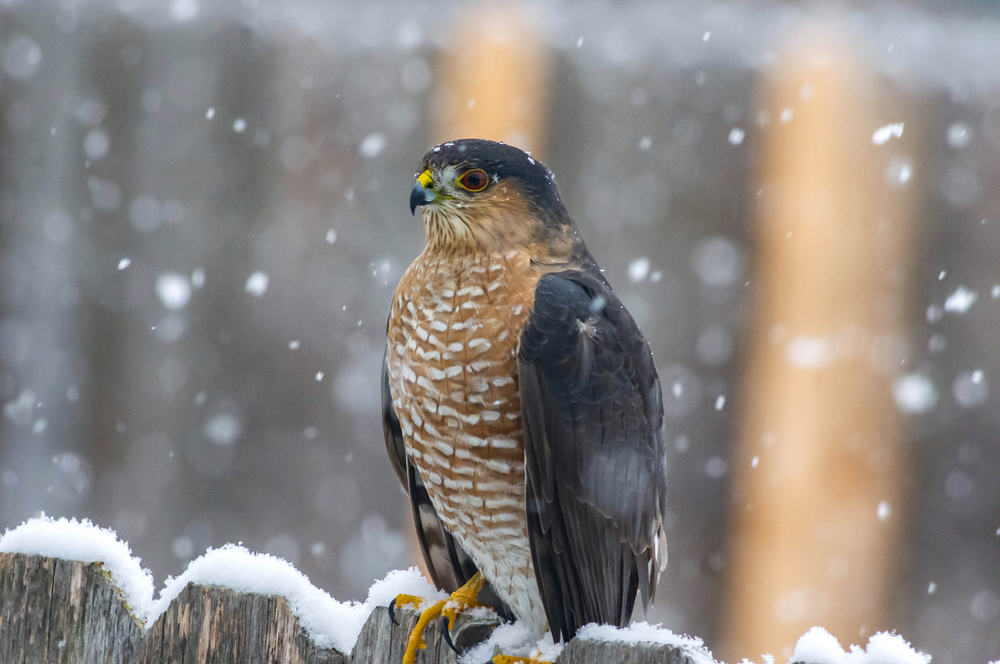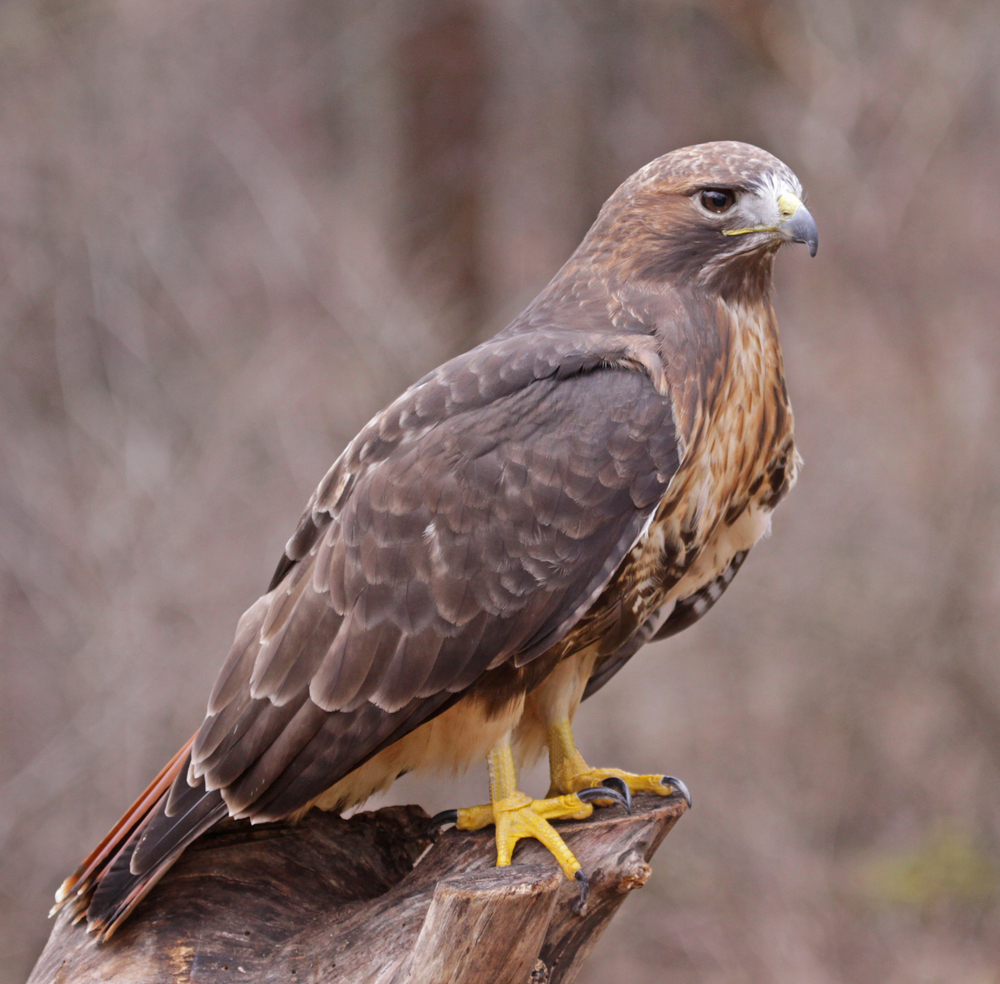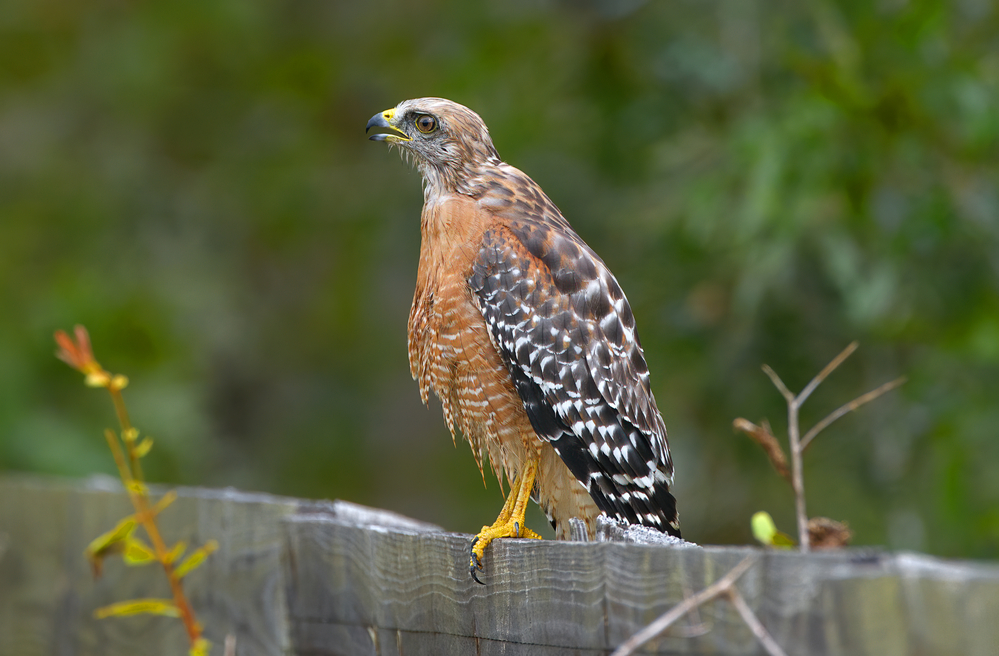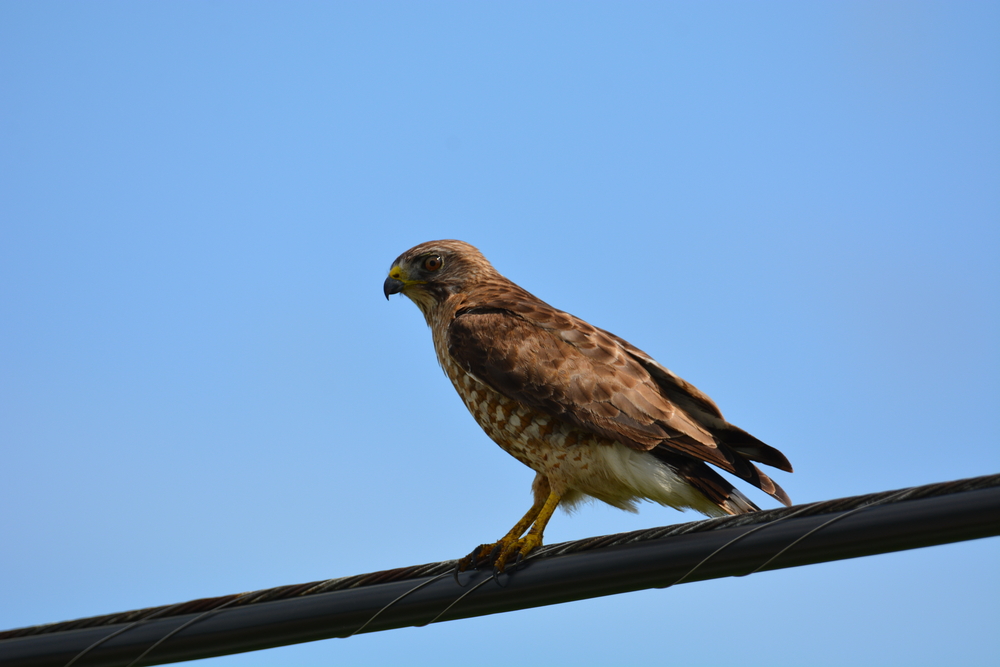The words “graceful” and “violent” don’t seem like they should be in the same sentence, but for the purposes of describing a hawk, they work perfectly together. Hawks are gracefully violent, elegantly fierce. When these master predators are circling the sky, every creature below them on the ground and on the food chain either scrambles for cover or freezes in place. Human observers may also stop what they’re doing when a hawk shows up, not because we’re on the menu, but rather to marvel at their powerful beauty and their lethal athleticism.
The first hawks evolved 25 million years ago and there are over 200 species worldwide. But in itself, the term “hawk” is a used to describe a large variety of raptors that are very loosely related, all of which are equipped with the deadly weapons of hooked talons and hooked beaks. In taxonomy, diurnal birds of prey (those that hunt by day) are grouped under the order Falconiformes. Within that order are three families: Falconidae, which are falcons, Cathardidae, which encompass the scavenging condors and vultures, and Accipitridae, which includes eagles, kites and hawks.
To confuse matters a little more, within the Family Accipitridae is the genus Accipiter, which are bird hawks, and the genus Buteo, which includes North America’s most common predator of the skies, the Red-tailed hawk. In ornithology, birds in the Accipiter genus are considered the “true hawks.” In much of the world, the Buteo genus, which Americans most closely associate with hawks, are commonly known as buzzards. Then there’s the Osprey, known colloquially as a Fish Hawk but grouped into a subfamily of its own, and the Northern Harrier, which shares many similar traits to other hawks but is different enough to be classified into a separate genus.
The good news is you don’t have to remember everything you learned in high school biology to enjoy observing these birds in the wild. The better news is that Georgia is a great place to see the hawks in action, and not just on the basketball court in Atlanta.
7 Types of Hawks in Georgia
Here are the most common hawks found in Georgia:
Cooper’s Hawk (Accipiter cooperii)

Cooper’s Hawks are the larger of the two species of bird hawks found in Georgia. They are about the size of crows and flourish in both deep forests and among human development. They can be identified first by their color; the cinnamon-barred stripes of an otherwise white breast contrast with a steely blue-gray back, crown and tail. The tail and the underside of the wings also feature a pattern of bold, black stripes that are conspicuous in flight. Juvenile birds start off with similar patterns in their feathers but are mostly brown.
Though not as blindingly fast as a Peregrine Falcon, the Cooper’s Hawk is sufficiently swift and agile enough to kill the birds which make up most of its diet, although it will also hunt small mammals, and even reptiles, amphibians and insects.
The Cooper’s Hawk and its accipiter cousin, the Sharp-shinned hawk, generally don’t hunt in the circling and diving manner that we associate with a hawk. Instead, they are stealth and pursuit hunters, stalking their prey either from natural perches or from deep within the foliage of trees, then attacking with a burst of lethal speed. They can attack victims in the trees or on the ground. Again unlike falcons, which grab prey with their beaks, Cooper’s Hawks latch on to prey with their talons and won’t eat their victim until it dies, even going to the extreme of dragging it through water to drown it.
But flying at a breakneck speed through the canopy exacts a price on Cooper’s Hawks. According to the Cornell Lab of Ornithology’s “All About Birds” website, 23% of the skeletons of 300 collected Cooper’s Hawks revealed evidence of old, healed-over breaks in the wishbone and the surrounding bones of the chest. To make matters worse for the male of the species, the female is bigger and bulkier, and will attack and kill the male if it gets out of line, or if its hungry. A male suitor must wait to hear a certain variation of the female’s barking call to know if it’s safe to approach her, then bow to her in a mating ritual before they build a nest together.
Cooper’s Hawks were named in 1828 for naturalist William Cooper, who collected the first specimens of the bird. While they do migrate, they travel relatively short distances compared to other hawks. While they are less common overall than Sharp-shinned hawks, they are full-time residents of Georgia, and can be found both gliding through forests and stalking suburban birdfeeders at any time of the year.
- Female Length: 16.5″ – 17.7″ / Wingspan: 29.5″ – 34.4″
- Male Length: 14.6″ – 15.3″ / Wingspan 24.4″ – 35.4″
- Georgia Status: Stable population; breeds in the state; somewhat common year-round
- Birding Hotspot: Jekyll Island, South Beach, Glynn County
Sharp-shinned Hawk (Accipiter striatus)

Sharp-shinned Hawks are the smaller of the two bird hawk species found in Georgia, but they pack a lot of power into a body no bigger than that of a Blue Jay or a Mourning Dove. They feed almost exclusively on any bird smaller than they are. The differences in appearances that distinguish the two species are subtle and can confound even well-experienced birdwatchers. The “Sharpie” has a smaller head and appears more sleek and less stocky than the Cooper’s Hawk. Then there are its legs, which are featherless and bright orange, hence its name. If observed in flight, the tail is the key to identification: The tail of Sharp-shinned is straight and cut at right angles at the tip, while the tail of the Copper’s Hawk is rounded. (The birder’s wisdom is to remember that “C” is for Cooper).
Like the Cooper’s Hawk, the female Sharp-shinned Hawk is larger and heavier than the male, which is given responsibility for most of the nest building. Both species choose nesting sites high up and deep within the branches of coniferous trees, and both species raise one brood a year, starting with 3-8 eggs which are incubated in about a month.
Some populations of Sharp-shinned hawks are long-distance migrants, while some that live in the Northeast and Northwest U.S. don’t migrate at all. Those that do travel are the one you will encounter in Georgia, where they are commonly seen in winter.
Like many migrating raptors, Sharp-shinned hawks gather into large flocks called “kettles” when in migration, taking advantage of thermals and mountain updrafts. Like Cooper’s Hawks, “Sharpies” fly using a “flap-flap-glide” technique to conserves energy. The bird will only beat its wings continuously if it’s in pursuit and needs to gain speed.
At the annual Hawk Mountain Hawk Watch in Pennsylvania, high counts of over a thousand migrating Sharp-shinned hawks at one time have been observed in October. Some of those birds are surely on their way to a winter layover in the warmer Georgia climate.
- Length 9.4″ – 13.4″ / Wingspan: 16.9″ – 22.1″ (Sexes Similar)
- Georgia Status: Stable population; common winter migrant
- Birding Hotspot: Chattahoochee River National Recreation Area, Cobb County
Red-tailed Hawk (Buteo jamaicensis)

No matter where you live in North America, if you look up and see a hawk circling above or perched high on a pole, the chances are overwhelming that it’s a Red-tailed hawk. The worldwide population of these birds is estimated to be more than 2 million. Like other raptor species, some populations are migratory and some aren’t. They are common year-round in Georgia, but numbers increase in winter when migrating northern birds arrive.
There are geographic variations in the coloring of red tails. Generally speaking, they are dark above and light below, and juvenile birds start lighter and grow darker. They have brown heads and a brown speckled band across the breast. The undersides of their wing feathers are barred white with bands of dark brown around the edges, and their eponymous red tail fans out to white tips. The adult wingspan of over four feet makes them look enormous, yet the larger female weighs just over three pounds. This aerodynamic design makes their acrobatic circling, soaring and diving seem effortless.
One of the Red-tailed Hawk’s deadliest weapons is its eyes. Its head is significantly smaller than a human head, yet our eyes are the same size. Hawk eyes are equipped with tightly packed receptors inside the retina that produce telescopic vision, resulting in the ability to see 8 times better than a human eye, with a wider spectrum of color. The “angry expression” in a Red-tailed Hawk’s eyes is something we project on them. It’s actually comes from a shield over the eye that protects it from sun and debris.
Male and female red tails engage in an amazing mating ritual, circling near each other a thousand feet in the sky. The male circles, dives and soars above the female, and will sometimes swoop down to exchange prey with her in mid-air. When she’s ready to mate, she finds a high perch and the male joins her. Their nests are built in the highest trees possible, sometimes 120 feet off the ground.
Both parents will take turns incubating 3-5 eggs for 28-35 days. The female then stays with the young hawks for another month or so, tearing food delivered by the male into bite-sized pieces. At some point, the female will also leave the nest, but she and the male will continue to deliver food to their offspring for several more weeks.
Not only are Red-tailed Hawks more likely to be seen than other hawks, they’re also more likely to be heard in TV shows and movies. The bird’s unmistakable piercing screech has been used as a stock Hollywood sound effect for years, even if the bird on the screen happens to be a Bald Eagle.
- Female Length: 19.7″ – 25.6″ / Wingspan 44.9″ – 52.4″
- Male Length: 17.7″ – 22.1″ / Wingspan 44.9″ – 52.4″
- Georgia Status: Most common hawk in the state; year-round resident
- Birding Hotspot: Harris Neck National Wildlife Refuge, McIntosh County
Red-shouldered Hawk (Buteo lineatus)

Red-shouldered hawks prefer the timbered swamps and warmer climate of the southern states. Most found in Georgia are permanent residents, although there are populations that breed in the Northeast and winter as far as Florida. It’s a bird that loves deep woods and water, and its distinctive call, like an amplified Blue Jay, is a common sound in the wilderness.
Red-shouldered Hawks are smaller and far less common than Red-tailed Hawks, but have noticeable markings that set them apart, including the red shoulders for which they’re named. Their body shape is slimmer than a red tail’s, closer to that of a bird hawk’s. In flight, you will observe that their undersides are reddish brown, and their tail is longer than that of other hawks. The tail has thick black stripes alternating with what has been described as “translucent windows” of white feathers. If you see the bird perched, you’ll notice the red shoulders, as well as an intricate black and white pattern on its back, completely different that the red tail’s tawny brown back feathers.
Red-shouldered Hawks hunt from perches more than from on the wing. They consume a wide variety of prey, including crayfish in their southeast range, where the birds remain fairly common. Unfortunately, their populations have not kept up with other birds of prey, and while the Red-tailed Hawk has adapted to urban areas, the fragmentation of forest habitat has put stress on the population of Red-shouldered Hawks, which is estimated to be around 100,000 individuals worldwide.
- Length 16.9″ – 24″ / Wingspan: 37″ – 43.7″ (Sexes Similar)
- Georgia Status: Stable Population; breeds in the state; common year-round
- Birding Hotspot: Oxbow Meadows Environmental Learning Center, Muscogee County
Broad-Winged Hawk (Buteo platypterus)

No bigger than a crow, the Broad-winged Hawk is the smallest of the Buteo species found in Georgia. Their wings are dark brown above and white below like a red-tail, but with a reddish-brown breast similar to but not as dark as that of the Red-shouldered Hawk. Besides their smaller size and their broader and shorter wingspan, they are set apart in flight by bold, black stripes that fan out across their rounded tail feathers. Both breeding populations and migrating birds can be found in the state, but all of them winter in Central and South America.
The call of the Broad-winged Hawk is almost songbird-like, a high, long whistle very unlike their louder Buteo cousins. You’re more likely to hear them than see them, as they are very good at finding secret nesting sites and will return to the same spot year after year. They will circle above their territory to protect it, but they spend most of their time in the canopy. They don’t stray far from forest edges, even in pursuit, and will supplement their diet with insects during the summer.
Broad-winged Hawks are noted for the huge kettles they form in migration. Thousands of individuals have been observed traveling together along the Atlantic Coast within two-week periods in the fall. Unlike songbirds, hawks don’t “fatten up” for migration, but instead rely on natural updrafts and air thermals to expend as little energy as possible in flight.
- Length: 13.4″ – 17.3″ / Wingspan: 31.9″ – 39.4″ (Sexes Similar)
- Georgia Status: Common year-round in northern GA, seen in migration in southern GA
- Birding Hotspot: Rum Creek Wildlife Management Area, Monroe County
Osprey (Pandion haliaetus)

Although the worldwide population of Red-tailed Hawks outnumbers that of Ospreys by a million and a half birds, if you live in one the counties of Southern Georgia that borders Florida and observe a large bird of prey patrolling an inland waterway, it’s as likely to be an Osprey as a red tail. The bird colloquially known as a Fish Hawk is in a subfamily of its own, and in a class of its own when it comes to raptor acrobatics.
Despite a smaller body than a Red-tailed Hawk, the Osprey’s wingspan is almost two feet wider.
They have a solid white breast and head and a brown back. The key field marking when looking at a perched bird is a brown stripe extending from its eyes to its throat which looks like a bandit’s mask.
Their hunting method is what truly sets the Osprey apart from other hawks. It hovers with its huge wings positioned upright and hooked back at the ends before dive-bombing at incredible speed into the water and emerging with a fish clenched in its uniquely designed talons. For aerodynamic purposes, it will turn the fish around so it can be carried back to the nest head-first.
Like Red-tailed Hawks, Ospreys have successfully adapted to expanding human habitat. The birds have been known to disrupt communication and electrical grids by building their huge platform nests on utility poles. As their numbers expand, more communities and individuals are erecting Osprey platforms to encourage safer nesting.
- Length: 21.3″ – 22.8″ / Wingspan: 59.1″ – 70.9″ (Sexes Similar)
- Georgia Status: Common breeder in Counties bordering Florida; seen in migration
- Birding Hotspot: Cumberland Island National Seashore, Camden Coounty
Northern Harrier (Circus cyaneus)

Northern Harriers can be identified as much by where they are and what they’re doing as they can by what they look like. They are long, sleek hawks, who differ in appearance by sex: The male has a dark grey head and back compared to the brown female. Both are buffed white on the underside, with faces that look more owl-like than hawk-like. While they have the eyes of a hawk, they also have the ears of an owl, with better hearing ability than most raptors.
Harriers live in wetlands, marshes and near open fields, with a unique strategy of flying low over wide-open spaces with wings in a V-shape, hunting for small prey which they eat on the ground. They also nest on the ground in dense vegetation, and unlike most hawk species, they are not monogamous. The male harrier might support several nesting females at one time. While they don’t breed in Georgia, they can be found from fall into spring in large, undisturbed areas, mostly along the coast or along inland waterways.
Populations of Northern Harriers are declining mostly due to the specialized demands of their habitat. The birds need a lot of wide-open country to hunt successfully, and they have not adapted to the increased human development that has fragmented the landscape.
- Length: 18.1″ – 19.7″ / Wingspan 40.2″ – 46.5″ (Sexes Similar)
- Georgia Status: Declining population; winter migrant to the state
- Birding Hotspot: Altamaha Wildlife Management Area – Butler Island, McIntosh County
Protecting Hawks
It took humanity as a whole a long time to fully realize the crucial and irreplaceable role that hawks play in our ecological balance, and the overall success of most raptor species today is proof that we can learn from our mistakes and protect these magnificent birds as they live their natural lives in their natural habitats.
Hawks were persecuted, trapped and shot in large numbers for hundreds of years in this country, often for sport, until passage of the Migratory Bird Act of 1918. Later in the Twentieth Century, their numbers were decimated by the use of the pesticide DDT, which was first developed to treat malaria carrying mosquitos in 1948. Rachel Carson, author of the groundbreaking 1962 book Silent Spring, was among the scientists who discovered that poisoning from DDT affected birds by thinning the shells of their eggs. Birds of prey were especially vulnerable to ingesting DDT due to their position at the top of the food chain, and several species, most notably the Bald Eagle, were very nearly driven to extinction before the pesticide was banned nationally in 1972.
The Clean Air Act of 1970, as well as the concerted efforts of individuals and conservation groups that were born out of that era, have helped hawks regenerate their numbers over the last 50 years. As we’ve seen, many of Georgia’s hawks are doing well, but those that require a more specialized habitat will need more direct protection in the future.
